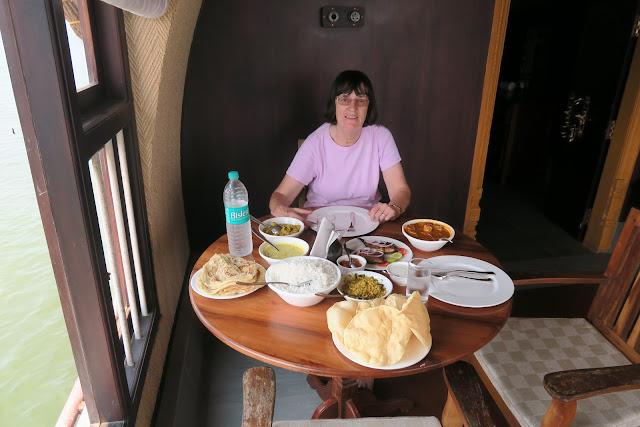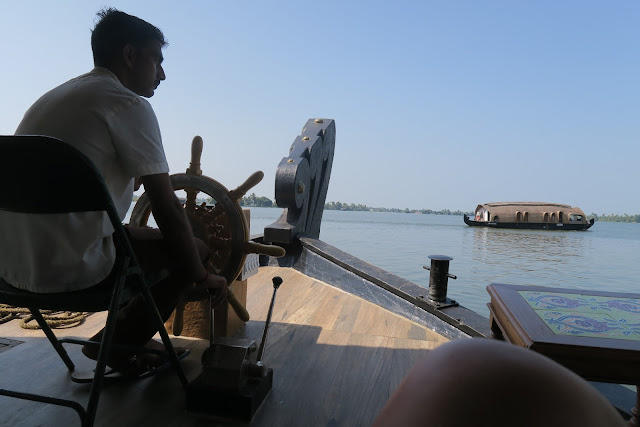A Low Stress Day Exploring a Small Part of the Kerala Coast
Insect Attack
 |
| Kerala |
 |
| India |
I awoke in the night with a sharp pain in my thigh. I ignored it and tried to go back to sleep; I may even have been successful for a while, but the pain returned and it was in several other places as well. I got up and went into the next room not to disturb Lynne - you can do this when you have been upgraded to a two-room cottage.
Minutes later Lynne was asking where I had got to. I went back in, turned on the light and discovered that my side of the bed was seething with ants – very small but with large teeth - and they were now beginning to invade Lynne's side. From 4.15 to 4.30 I stood and scratched while Lynne set about mass insecticide, boiling a kettle and pouring the contents into the crack they were emerging from. Being awake at this hour is not unusual for me and an ant attack was more interesting than insomnia.
 |
The scene of the attack
It is now 04.38 and the ants are all dead |
A message on our arrival yesterday had informed us that our early morning elephant ride had been cancelled - the Maha Shivaratri (Great Night of Shiva) festival had commandeered all available beasts. Never mind, after the night’s events we were happy to rise at a reasonable hour and enjoy a leisurely breakfast. Omelette and parathas (Lynne) or idlis and chutney (me) were followed by fresh fruit. Breakfasts on this trip had offered surprisingly little pineapple thus far; this morning there was plenty of it, fresh, sweet and luscious.
 |
| A bright, fresh clean, Kerala morning |
The Death of Kalabhavan Mani and an Unforgettable Newspaper Headline
We met Thomas outside at 9.00. Over lunch the previous day we had been talking about Malayalam language cinema and today he greeted us with the information that Kalabhavan Mani, one of ‘Mollywood’s’ biggest stars had died aged 45 under suspicious circumstances.[update April 2017: Police are still investigating whether he died of alcoholism or was poisoned] It was a lead story in the Deccan Chronicle under the unforgettable headline 'Mani Dies, Cops Smell Foul'.
 |
Mani dies, cops smell foul
The front page of the Deccan Chronicle 07/03/16 |
To be fair to the Deccan Chronicle, price 3rps (3p), it is a serious newspaper. It covers local, national and fair amount of international news in a straightforward manner and its editorial and columns are generally moderate and thoughtful – the same cannot be said of much of the British press. Today’s reported crimes included a horrific 'honour killing' and the story of some Hindu youths violently attacking the congregation of a Christian church during a service. There is nothing funny about either story, but the second finished with another gem of Indian English: 'Superintendent Neeraj Chandrakarsa said..."efforts are on to nab the miscreants."
Varkala Beach
Not only were the elephants off, Thomas said, but so too was the coir factory visit (closed for the festival) and the cashew processing plant (on strike for the last three weeks - well, this is Kerala.) Our day seemed to have crashed and burned, but Thomas suggested we visit Varkala Beach, some fifteen kilometres away.
The drive was short, despite the hold-up at a level crossing.
 |
| Level crossing on the way to Varkala |
North Helipad Cliff Road
Varkala Beach car park has a large H marked on it after a VIP visit some years ago. I doubt it has seen a helicopter since, but the cliff top road - the only cliff on the South Kerala coast - is known as North Helipad Cliff Road.
 |
| Varkala is just south of Kollam, but too close to mark separately on a map this size |
The road was lined with cafés, restaurants and shops, the clientele mostly European and the menus more Italian than Indian, though one restaurant was called 'Taste of Tibet'. Tibet is a wonderful place, and we thoroughly enjoyed our 2005 visit but the air is thin and the food is, well, regrettable. Yak butter, with its distinctive flavour of decay is unavoidable it turns up in your tea and also in tsampa, the national staple where it is pounded with roasted barley. The result tastes like rancid sawdust, but Tibetans nibble it constantly. I deplore the officially supported Chinese migration that has made Tibetans a minority in their own capital city, but if it had not been for their restaurants we would have gone hungry - though I should also give an honourable mention to Lhasa's many Nepalese restaurants, I enjoy a yak curry. Having learned to avoid Tibetan restaurants in Tibet, the chances of us choosing one in India were vanishingly small.
We dropped into a shop and after a fierce but light-hearted bargaining session bought a couple of table cloths and two shirts. The shopkeeper accused me of taking the food from the mouths of his children, but he had a big smile on his face, so I took it as a compliment for trying, being well aware that he knew the price he had paid for the merchandise and I did not. No doubt he made a handsome profit and we parted the best of friends.
The area is a pleasant tourist trap overlooking a clean beach lapped by the warm waters of the Arabian Gulf. It is a mini Goa, but it is not really India so we had a coffee and drove on to Varkala town.
 |
| Varkala Beach |
Papanasam Beach
North Varkala is full of European holidaymakers but the town at the south end is full of pilgrims. People flock to the (allegedly) 2,000 year old temple (with limited access to non-Hindus) for a final blessing of the ashes of their late relatives. The activity continues on Papanasam Beach where a line of priests have set up sand altars to commemorate those whose ashes are heading for the big blue yonder.
 |
| Priests on the beach, Varkala |
Behind them the beach is busy; there were no foreign tourists, but a long, thin, throng lined the water’s edge, not quite bathing, the women, as usual inching into the water fully clothed.
 |
| A long dress might not be ideal for paddling, Varkala Beach |
To add a little diversity we joined them for a paddle.
 |
| Lynne on Varkala Beach |
Following Jackfruit to lunch
Leaving Varkala we drove north towards (I think) Parippally, briefly following a truck full of jackfruit. Though little is grown commercially, the huge fruits are abundant, hanging from trees beside the road, in gardens and in courtyards. The truck driver will pay the tree's ownner a few rupees, take away the fruits and distributes them to local markets. Cheap and underrated (jackfruit rarely makes it to a hotel breakfast buffet) it splits open to reveal rows of large seeds surrounded by bright yellow pulpy jackets, the sweet pulp tasting exactly like the synthetic banana flavour of the ice-lollies of my youth.
 |
| Following the jackfruit through Kerala |
We passed through a town (though which town, I do not know)….
 |
| A town in southern Kerala. What town? Dunno |
Beyond the town Thomas selected a restaurant for lunch. It looked unimpressive, but Thomas’ track record is good so we followed willingly. On his advice we ordered a tuna-like fish curry, an unspecified fried fish and masala crusted pearl spot. The pearl spot (officially Green Chromide) is a small oval fish with a distinctive circular spot at the base of the pectoral fin. It thrives in the brackish conditions of the Kerala Backwaters and in 2010 was declared Kerala’s ‘State Fish’. Highly regarded but too expensive for many locals they are frequently served to tourists – and we should be grateful for our good fortune.
 |
| Lynne, Thomas and a pearl spot at lunch |
Accompaniments included cabbage with coconut, pickles, sambar, poppadums and drumsticks. Drumsticks are long (drumstick shaped!) pods which can be seen hanging from trees everywhere. The jelly-like pulp has to be scraped from the inedible pods which are invariable served split. The locals like them, but I have never quite seen the point.
Lunch over there was little else to do but return to our hotel and the sybaritic pleasures of a lakeside resort.
 |
| This post started (almost) with the view across the lake from the back of our bungalow. It finishes with the view from the front. |
We paused in reception to inform them, a touch belatedly, of last night’s ant antics. I do not know exactly what I expected, perhaps an apology and the immediate dispatch of a fumigating minion, but we received a half smile and a jar of insect repellent. I doubt that was four-star service, but no matter, Lynne’s boiling water had already done the trick.
























































